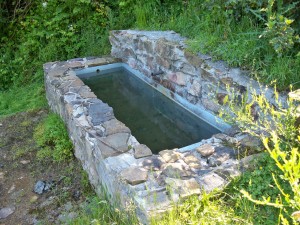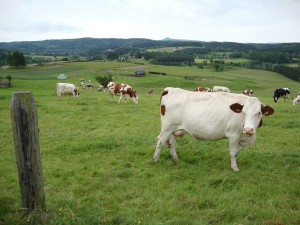Managing water and feed is very important in livestock farming during the hot days of late spring and summer. As the days get warmer, your animals will be more prone to heat stress.
Heat stress will affect your livestock growth. As their body temperature rises, their natural reaction will be to reduce food intake. Proper feeding and water management is needed to reduce heat stress, improve production, and increase your profits from livestock farming. Below are some tips for reducing heat stress in livestock.
Water for livestock
Water is essential for life. Shortages of water can lead to weight loss in animals, reduced food intake, and reduced meat and milk production.
“UK – A University of Cambridge report is right to suggest that collaboration is crucial to ensuring the careful management of our water resources – and it is essential that farmers and growers can produce food in times of plenty and drought, the NFU said.” – The Beef Site
 In recent years water is becoming increasingly scarce. It’s because the growth of the global population, pollution and global warming is causing alterations in the hydrological cycles.
In recent years water is becoming increasingly scarce. It’s because the growth of the global population, pollution and global warming is causing alterations in the hydrological cycles.
You cannot always rely on rain to irrigate and cool your pastures down. Natural sources of water during a drought or hot summer days may get dried and become insufficient. Building more effective on-farm reservoirs for storing water could be one way to cope with water shortages. Judging from experience, it might be a good idea to store water to last at least during your dry seasons.
Your animals should have access to clean and cool drinking water at all times. Make sure you check all their water containers periodically and keep them filled. Also have alternate water sources available in your pasture to avoid animals crowding around one. It is also important to maintain drinking water quality. Recycle soiled water by using it for irrigation to minimize waste.
Check the drinking water quality regularly because water quality can affect both the total water consumption and overall health of livestock. Water can be a carrier for many parasites and bacteria which could make your animals sick.
Livestock feed management
Animals can feel heat stressed as the day temperature rises above 70 degrees. Excessive heat changes the metabolic energy needed for animals to maintain their body temperature and normal body functions. It’s important to determine how stressed your animals are, due to heat, humidity, air circulation, etc. Heat stress can adversely affect animal health, performance and wellbeing
 The natural reaction of livestock during a hot summer day is to reduce food intake because their body temperature rises. This could lead to thinner and weaker animals who are more vulnerable to diseases. A diet that is easily digested, highly nutritious, and does not produce heat is ideal for keeping the body temperature down.
The natural reaction of livestock during a hot summer day is to reduce food intake because their body temperature rises. This could lead to thinner and weaker animals who are more vulnerable to diseases. A diet that is easily digested, highly nutritious, and does not produce heat is ideal for keeping the body temperature down.
Profitable feeding is about achieving a balance between pasture grass and supplemental feeds. Your pasture grass quality and quantity will decline during the hot summer days. To get the most out of your pasture grasses, you should be able to control growth in your pastures with thoughtful rotation of your grazing. Also check the nitrate content of your pasture plants, this is an indicator of your pastures quality.
Using sprinklers and offering cows to graze during the evening when the temperature is cooler may reduce summer stress in cattle.
Conclusion:
Increase in surface temperature and unpredictable weather has made it necessary for livestock farmers to take extra precautions on hot summer days. During the hot days of summer, it is important to reduce heat stress in animals. It’s also important that you provide them with enough clean and cool drinking water, shade, and proper nutrition.
Feeding a balanced diet, avoiding over feeding and providing a steady supply of cool clean water for your livestock will increase the production of your farm. Avoid diets too high in fiber that take too long for the cows to process. When all your resources are in balance, there will be no waste and maximum profit.
P.S: – You could supplement your livestock with luscious micro-green grasses that are highly nutritious and easily digestible. Grow your own microgreens with our micro-green fodder system. Have you tried our DIY systems? Now is the best time to grow your own micro-green fodder. Click here to get DIY plans for proven livestock feeding systems.
To learn how you can setup a DIY system please contact us at 303-495-3705 or Click here to book a meeting with us. You can also get your Feed in A Box Microgreens (fodder) from us, you will absolutely love it!!
Please leave your questions or comments in the comment box below or visit our Facebook Page and leave your comment there. We’d really appreciate it.
Source: Sustainable Livestock Nutrition
Related articles and resources:
- Tips on Animal Welfare – How to Care for Livestock during Droughts | Sustainable Livestock Nutrition
- Concerns About Droughts And Providing Water To The Livestock | Sustainable Livestock Nutrition
- Interpretation of Water Analysis for Livestock Suitability
- Tips on Pasture Management & Feeding Heat-Stressed Livestock | Sustainable Livestock Nutrition
- DEPI – Managing pasture and cow performance over the hot summer period
- Heat Stress and Forage Feeding Approaches – Part 1 | Amaferm



